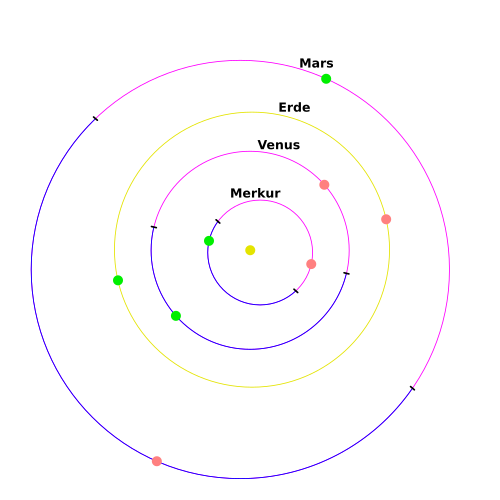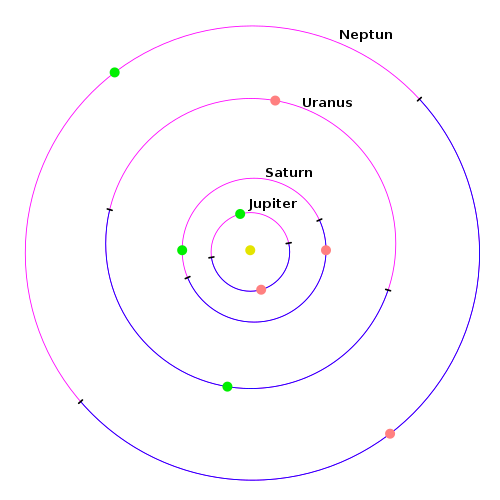List of the planets of the solar system
This article contains a tabular overview of the planets in the solar system .
| Earth-like planets | Gas planets | |||||||
|---|---|---|---|---|---|---|---|---|
| Mercury | Venus | earth | Mars | Jupiter | Saturn | Uranus | Neptune | |
| image |

|

|

|

|

|

|

|

|
| Astronomical symbol |
|
|
|
|
|
|
|
|
|
Large orbit half axis in km, in AU |
57,909,175 0.38709888 |
108,208,930 0.72333193 |
149,597,890 1 |
227,936,640 1.5236621 |
778.412.020 5.2033623 |
1,426,725,400 9.5370690 |
2,870,972,200 19.191261 |
4,498,252,900 30.068960 |
| Numerical eccentricity of the orbit | 0.20563069 | 0.00677323 | 0.01671022 | 0.09341233 | 0.04839266 | 0.05415060 | 0.04716771 | 0.00858587 |
| Period of rotation in sidereal years | 0.2408467 | 0.61519726 | 1 | 1.8808476 | 11.862615 | 29,447498 | 84.016846 | 164.79132 |
| Mean orbital speed in km / s | 47.8725 | 35.0214 | 29.7859 | 24.1309 | 13.0697 | 9.6724 | 6.8352 | 5.4778 |
| Inclination | 7.00487 ° | 3.39471 ° | - | 1.85061 ° | 1.30530 ° | 2.48446 ° | 0.76986 ° | 1.76917 ° |
| Length of the ascending node (J2000) | 48.33167 ° | 76.68069 ° | −11.26064 ° | 49.57854 ° | 100.55615 ° | 113.71504 ° | 74.22988 ° | 131.72169 ° |
| Length of periapsis (J2000) | 77.45645 ° | 131.53298 ° | 102.94719 ° | 336.04084 ° | 14.75385 ° | 92.43194 ° | 170.96424 ° | 44.97135 ° |
| Maximum apparent brightness | −1.9 m | −4.6 m | - | −2.91 m | −2.94 m | 0.43 m | 5.32 m | 7.78 m |
| Mean equator radius in km, relative to the earth's radius |
2,439.764 0.3825 |
6,051.59 0.9488 |
6,378.15 1 |
3397 0.5326 |
71,492.68 11.209 |
60,267.14 9.449 |
25,559 4.007 |
24,764 3.883 |
|
Volume in 10 12 km³, relative to the earth |
0.0608272 0.056 |
0.92840 0.86 |
1.0832 1 |
0.16314 0.15 |
1425.5 1316 |
827.13 763.6 |
69.142 63.8 |
62.526 57.7 |
|
Mass in 10 24 kg, relative to the earth's mass , relative to the total mass of all 8 planets |
0.33022 0.055270 0.00012 |
4.8685 0.81499 0.00182 |
5.9737 1 0.00224 |
0.64185 0.10745 0.00024 |
1898.7 317.84 0.71157 |
568.51 95.169 0.21306 |
86.849 14.539 0.03255 |
102.44 17.149 0.03839 |
|
Density in g / cm³, relative to the earth |
5.43 0.984 |
5.24 0.95 |
5.515 1 |
3.93 0.714 |
1.33 0.241 |
0.7 0.125 |
1.3 0.23 |
1.64 0.30 |
| Average acceleration due to gravity in m / s², relative to the earth |
3.7 0.377 |
8,872 0.905 |
9.80665 1 |
3.72076 0.379 |
24.79 2.528 |
10.44 1.065 |
8.87 0.904 |
11.15 1.137 |
| Escape speed in km / s | 4.25 | 10.36 | 11.18 | 5.02 | 59.54 | 35.49 | 21.29 | 23.71 |
| Period of rotation in sidereal days | 58,646225 | 243.0187 | 1 | 1.02595675 | 0.41354 | 0.44401 | 0.71833 | 0.67125 |
| Sense of rotation of its own | straight | declining | straight | straight | straight | straight | declining | straight |
| Inclination of the equator to orbit | 0.0 ° | 177.3 ° | 23.45 ° | 25.19 ° | 3.12 ° | 26.73 ° | 97.86 ° | 29.58 ° |
|
Surface temperature in K : minimum, average, maximum |
100 440 780 |
710 737 770 |
213 288 331 |
186 210 297 |
150 165 180 |
130 135 140 |
74 76 78 |
70 73 76 |
| Mean atmospheric temperature at zero level in K. | 737 | 288 | 165 | 135 | 76 | 73 | ||
| Main components of the atmosphere | O 2 , Na | CO 2 , N 2 | N 2 , O 2 , Ar | CO 2 , N 2 , Ar | H 2 , He | H 2 , He | H 2 , He , CH 4 | H 2 , He , CH 4 |
| Number of known moons | 0 | 0 | 1 | 2 | 79 | 82 | 27 | 14th |
| Rings | No | No | No | No | Yes | Yes | Yes | Yes |
See also
- List of moons of planets and dwarf planets
- List of dwarf planets of the solar system
- List of asteroids
Web links
- GFSC / NASA: Planetary Fact Sheet - Metric. Planet facts overview (English).
Individual evidence
- ↑ a b track elements. Medium track elements (J2000). In: univie.ac.at. University of Vienna, January 24, 2014, accessed on March 6, 2020 .
- ↑ Mercury does not have an atmosphere in the conventional sense, because it is thinner than a vacuum that can be achieved in a laboratory.
- ^ David R. Williams: Mercury Fact Sheet. In: nssdc.gsfc.nasa.gov. NASA, September 27, 2018, accessed March 6, 2020 .

